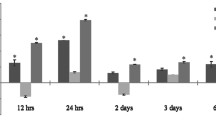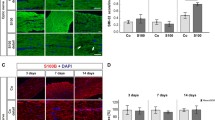Abstract
It has been proposed that the introduction of foreign material into the eye at the moment of a penetrating trauma provides an adjuvant effect which, coupled with the release of antigen, might be responsible for sensitizing the immune system to produce a contralateral “sympathetic ophthalmia.” We addressed that hypothesis by injecting S-antigen with complete Freund's adjuvant (CFA) into the anterior chamber (AC) of the eye of Lewis rats. The injection of an identical dose of antigen (30 μg S-Ag in CFA in a total volume of 10 μl) via the foodpad (FP) or under the conjunctiva (SC) could induce typical experimental autoimmune uveitis (EAU). By immunizing via the AC route, we could demonstrate a positive sensitization of the immune system, manifested by serum antibody production against S-Ag and by the presence of S-Ag-specific, responsive T-lymphocytes in the spleen. However, immunization via the AC route did not induce contralateral uveitis, and the animals did not produce a DTH skin response when challenged intradermally with S-Ag as they did after FP immunization. In the light of these results, we evaluated the possibility that a DTH suppressive response was elicited by intracameral (IC) injection as seen in anterior chamber-associated immune deviation (ACAID): we tested the effect of splenectomy and cyclophosphamide pretreatment before IC immunization and the effect of secondary footpad immunization as well as T-helper cell transfer after IC immunization. The results given by these approaches argue against the induction of suppressor cells by IC immunization. We believe that the absence of lymphatic drainage from the interior of the eye is probably responsible for the absence of EAU induction through the IC route and that extrusion of the antigen under the conjunctiva might be required for the activation of EAU effector cells.
Similar content being viewed by others
References
Billingham RE, Silvers WK (1964) Studies on homografts of fetal and infant skin and further observations on the anomalous properties of punch skin grafts in hamsters. Proc R Soc Lond (Biol) 161: 168–190
Caspi RR, Roberge FG, McAllister CG, El-Saied M, Kuwabara T, Gery I, Hanna E, Nussenblatt RB (1986) T cell lines mediating experimental autoimmune uveoretinitis (EAU) in the rat. J Immunol 136:928–933
de Kozak Y, Sakai J, Thillaye B, Faure JP (1981) S antigen-induced experimental autoimmune uveo-retinitis in rats. Curr Eye Res 1:327–337
Faure JP (1980) Autoimmunity and the retina. Curr Top Eye Res 2:215–302
Kaplan HJ, Stevens TR (1975) A reconsideration of immunological privilege within the anterior chamber of the eye. Transplantation 19:302–309
Kaplan HJ, Streilein JW (1974) Do immunologically privileged sites require a functioning spleen? Nature 251:553–554
Kaplan HJ, Streilein JW (1977) Immune response to immunization via the anterior chamber of the eye. J Immunol 118:809–814
Mage MG, Mathieson B, Sharrow S, McHugh L, Hammerling U (1981) Preparative nonlytic separation of LyT 2+ and LyT 2−T lymphocytes, functional analysis of the separated cells and demonstration of synergy in graft-vs-host reaction of LyT 2+ and LyT 2− cells. Eur J Immunol 11:228–235
Marak GE (1979) Recent advances in sympathetic ophthalmia. Surv Ophthalmol 24:141–156
Medawar PB (1948) Immunity to homologous grafted skin: III. The fate of skin homografts transplanted to the brain, to subcutaneous tissue and to the anterior chamber of the eye. Br J Exp Pathol 29: 58–69
Mochizuki M, Kuwabara T, McAllister C, Nussenblatt RB, Gery I (1985) Adoptive transfer of experimental autoimmune uveoretinitis in rats: immunopathogenic mechanisms and histological features. Invest Ophthalmol Vis Sci 26:1–14
Mostarica-Stojkovic M, Petrovic M, Lukic ML (1982) Resistance to the induction of EAE in AO rats: its prevention by the pretreatment with cyclophosphamide or low dose of irradiation. Clin Exp Immunol 50:311–317
Niederkorn JY (1984) Suppressed cellular immunity in mice harboring intraocular melanomas. Invest Ophthalmol Vis Sci 25:447–454
Niederkorn JY, Streilein JW (1983) Alloantigens placed into the anterior chamber of the eye induce specific suppression of delayed hypersensitivity but normal cytotoxic T lymphocyte and helper T lymphocyte responses. J Immunol 131:2670–2674
Niederkorn JY, Shadduck JA, Streilein JW (1981) Immunogenetic basis for immunologic privilege in the anterior chamber of the eye. Immunogenetics 13:227–236
Nussenblatt RB, Gery I, Ballantine EJ, Wacker WB (1980) Cellular immune responsiveness of uveitis patients to retinal S-antigen. Am J Ophthalmol 89:173–179
Nussenblatt RB, Kuwabara T, de Monasterio F, Wacker WB (1981) S-antigen uveitis in primates. Arch Ophthalmol 99:1090–1092
Rao NA, Cook GP (1980) Sympathetic uveitis. Contemp Ophthalmol 1:1–5
Rao NA, Robin J, Hartmann D, Sweeney JA, Marak GE (1983) The role of the penetrating wound in the development of sympathetic ophthalmia. Arch Ophthalmol 101: 102–104
Salinas-Carmona MC, Nussenblatt RB, Gery I (1982) Experimental autoimmune uveitis in the athymic nude rat. Eur J Immunol 12:480–484
Streilein JW, Niederkorn JY (1981) Induction of anterior chamber associated immune deviation requires an intact, functional spleen. J Exp Med 153:1058–1067
Vu Van Tuyen, Faure JP, Thillaye B, de Kozak Y, Fortier B (1982) Antibody determination by ELISA in rats with S antigen-induced uveitis. Curr Eye Res 2:7–12
Wacker WB, Donoso LA, Kalsow CM, Vankeelor JA, Organiscak DT (1977) Experimental allergic uveitis. Isolation, characterization, and localization of a soluble uveito pathogenic antigen from bovine retina. J Immunol 119:1949–1958
Wacker WB, Rao NA, Marak GE (1981) Immunopathologic response of rabbits to retinal S-antigen. Ophthalmic Res 13:302–311
Waldrep JC, Kaplan HJ (1983) Anterior chamber associated immune deviation induced by TNP-splenocytes (TNP-ACAID). Invest Ophthalmol Vis Sci 24:1086–1092
Wetzig RP, Foster CS, Greene MI (1982) Ocular immune responses: I. Priming of A/J mice in the anterior chamber with azobenzenearsonate-derivatized cells induces second-order-like suppressor T cells. J Immunol 128:1753–1757
Whittum JA, Niederkorn JY, McCulley JP, Streilein JW (1983) Intracameral inoculation of herpes simplex virus type I induces anterior chamber associated immune deviation. Curr Eye Res 2:691–697
Author information
Authors and Affiliations
Rights and permissions
About this article
Cite this article
Roberge, F.G., de Kozak, Y., Utsumi, T. et al. Immune response to intraocular injection of retinal S-antigen in adjuvant. Graefe's Arch Clin Exp Ophthalmol 227, 67–71 (1989). https://doi.org/10.1007/BF02169829
Received:
Accepted:
Issue Date:
DOI: https://doi.org/10.1007/BF02169829




